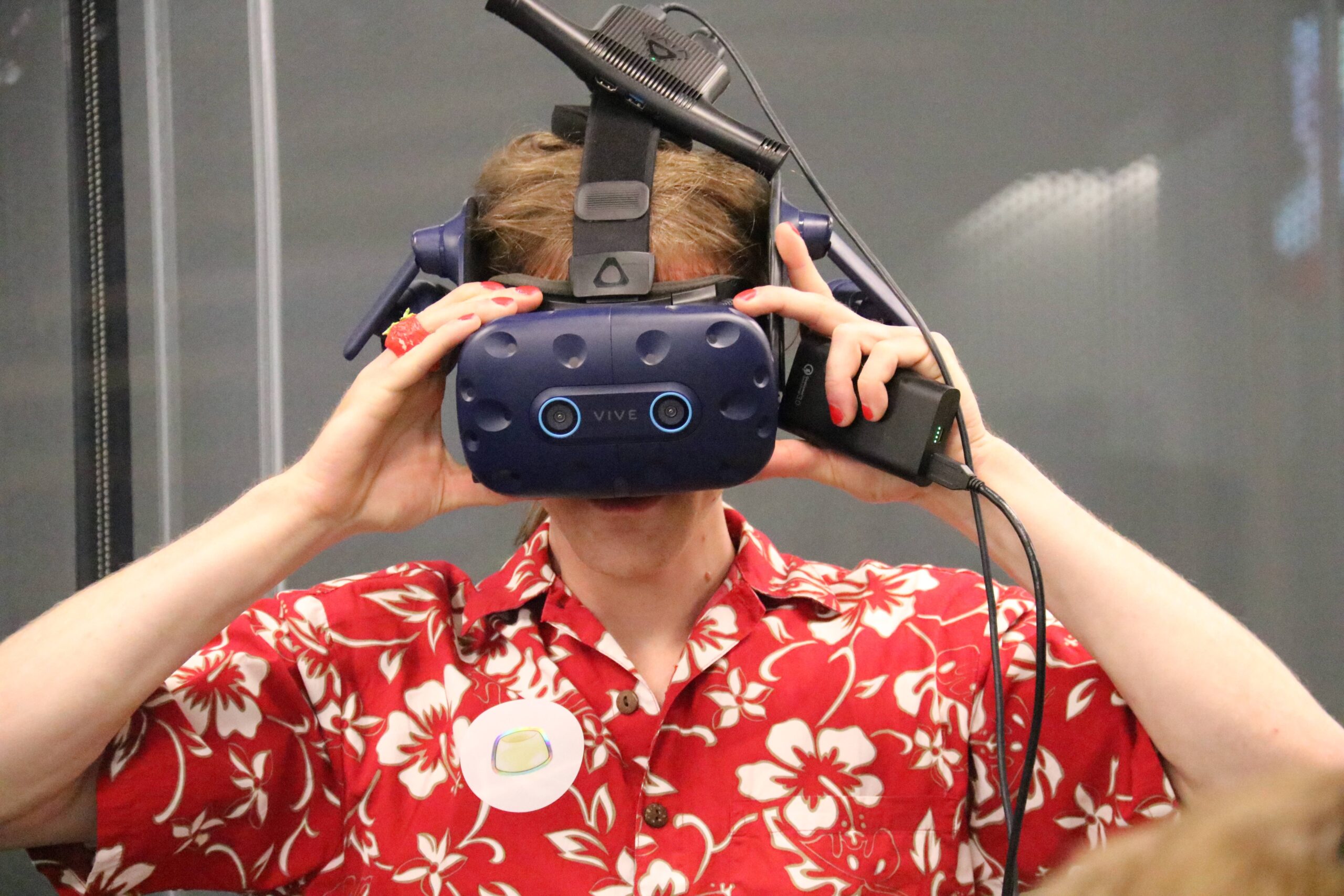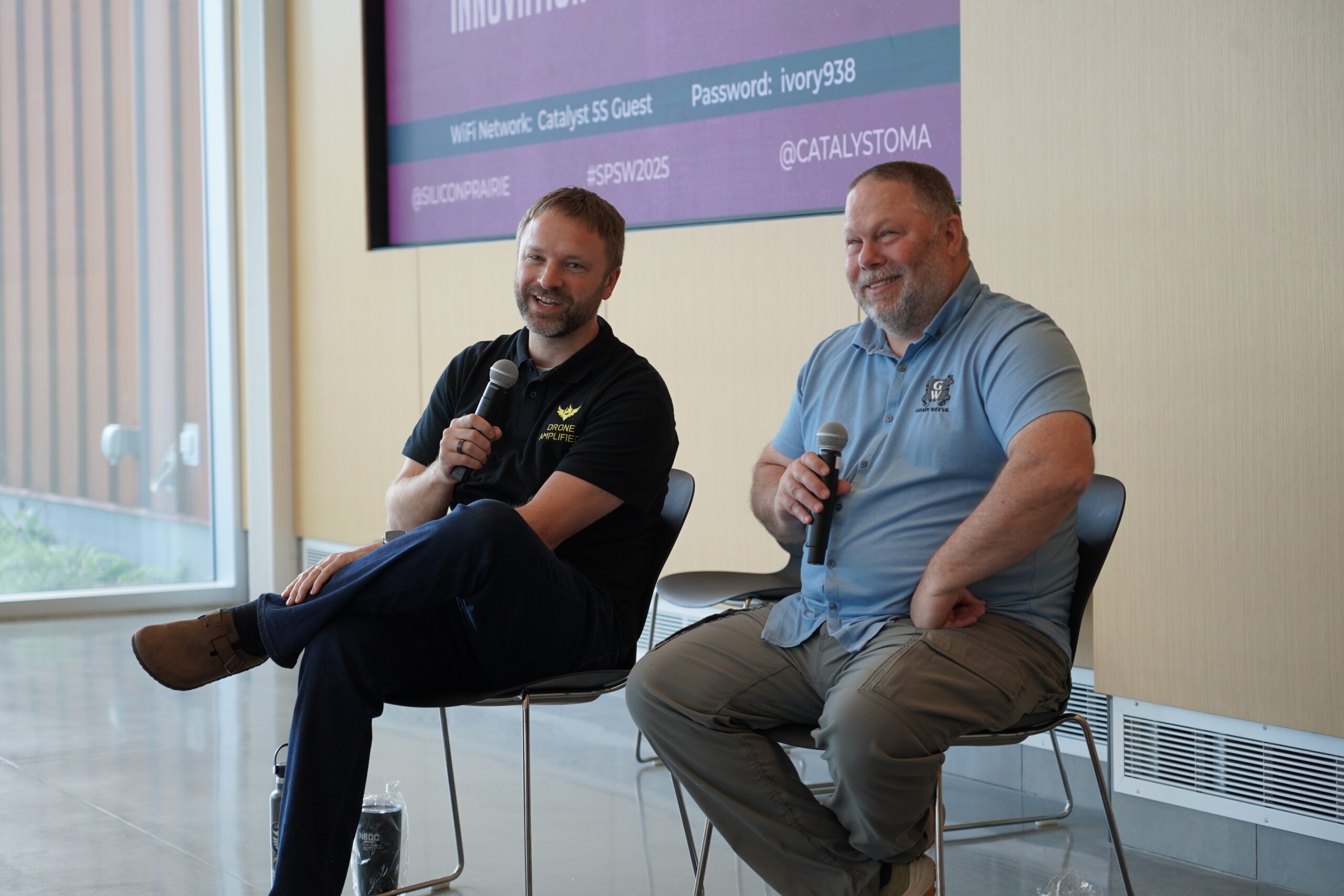“Innovation happens at the margins,” said Megan Elliott, founding director of the Johnny Carson Center for Emerging Media Arts. “And it just so happens that in this country, the margins are in the middle.”
In Nebraska, a place often overlooked in conversations about cutting-edge technology and creative disruption, Edgeworks is proof of the possibilities that emerge when artists, technologists and researchers sit at the same table.
Edgeworks is a research and digital production program located within the Johnny Carson Center for EMA, a state-of-the-art facility made possible by a $20 million gift from the Johnny Carson Foundation. Since opening in 2019, the Center has quickly become a catalyst for transformative, interdisciplinary work at the University of Nebraska–Lincoln.
Edgeworks officially launched in 2023, and operates at the intersection of creativity and computation. It tackles complex problems in sectors like public health, education and quantum computing through immersive design, storytelling and systems thinking. It’s part design studio, part research lab and part innovation engine — all fueled by students, faculty and alums from the Carson Center’s unique undergraduate program in Emerging Media Arts.
A program rooted in vision
Elliott, who spent years launching digital media labs around the globe before coming to Nebraska, the Carson Center, and by extension, Edgeworks, said it isn’t just another academic initiative. It’s a response to a cultural and technological moment defined by the climate crisis, automation and runaway artificial intelligence.

“Chaos is where, you’ll find, artists feel comfortable with ambiguity and the unknown,” she said at the 2024 IO Summit. “And as we’ve heard this morning, never before have storytellers and artists and creatives been so important to the world. This is a kairological moment in time. We are at a crossroads — and it is both terrifying and exciting.”
The Center graduates about 40 students per year, most of whom are trained as “emerging media artists,” a term that includes immersive experience designers, creative technologists and speculative storytellers. Many go on to work in industry, but some stay and contribute to Edgeworks, helping build immersive worlds and design media-based solutions for real-world problems.
“We need to educate startups and the broader ecosystem of employers about how these students can add value to their business,” said Elliott.
A research lab disguised as a studio
Edgeworks functions as a university service center, but behaves more like an outsourced R&D program. It offers everything from VR prototyping and AI-based simulations to design sprints and hardware-software integration.
“We’re creating a methodology… a way of thinking that allows the talent coming out of the Johnny Carson Center to attack problems in a very unique and very effective way,” said Ryan Schmaltz, productization advisor for Edgeworks.
Schmaltz, who brings experience from both public and private sector innovation labs, said that Edgeworks’ secret sauce is its hybrid approach. “It’s all sides of your brain working in concert. It’s like the symphony in your brain that’s happening.”
Edgeworks collaborates with faculty across the entire University of Nebraska system and partners with external organizations ranging from early-stage startups to national research institutes. Its clients don’t need to hire their own VR developer or AI specialist. They can test ideas, prototype products and visualize data with the Edgeworks team.
“We’re trying to bring the canon of Media Arts to what we think of historically as the hard sciences,” Schmaltz said. “At the national level, from NIH to NSF, what differentiates us is how media arts helps articulate very complex research.”
MuMu: Teaching STEM through story
One of the first tangible examples of Edgeworks’ mission in action is MuMu — Multispecies Multiplex — a virtual reality game designed to teach science and systems thinking to middle schoolers.
Led by Ash Smith, an assistant professor and co-principal investigator at Edgeworks, the project is part of Worlds of Connections, a five-year Science Education Partnership Award (SEPA) funded by the National Institutes of Health (NIH). The initiative aims to spark interest in biomedical and public health careers, particularly among underrepresented students, by offering compelling and accessible science experiences.The development team includes faculty from sociology, digital humanities, emerging media arts and public health, working alongside creative technologists from DOTDOT Studio and local partner Digital Sky.
“MuMu is Edgeworks’ very first XR experience,” Smith said at the IO Summit, “and it’s heralding a whole new generation of young people who now have the possibility of seeing themselves as scientists.”
Set on a speculative farm, players cycle through different perspectives — digging tunnels as a prairie dog, sensing water levels as a tree, planting crops as a robot, or analyzing patterns as a scientist.
As players move through these roles, they’re asked to make decisions and observe how even small actions ripple across the entire system. The gameplay is built around the One Health framework, a real-world public health model that emphasizes the interconnectedness of human, animal, plant and environmental health.
“When we start seeing the world through different lenses, we aren’t just playing a game,” Smith said. “We’re becoming master system thinkers, cracking the code of planetary health and climate futures.”
What makes MuMu exceptional is its focus on accessibility and engagement. Tested with middle schoolers from Park Middle School, Bay High and the NE STEM 4U program in Lincoln, the experience is designed to run on affordable hardware, work offline and be easily adapted for learners with physical disabilities.
“We know that capturing new interests and identities in middle school is infinitely important. If you want them to get into science and math, you need to capture [students] before they get to high school,” said professor of sociology at UNL Julia McQuillan, during the IO Summit.
“We know this from our own research in Lincoln, that girls and boys start sixth grade with similar science identities, but by the time they’re in eighth grade, the girls’ science identities have declined,” said McQuillan. “We’re working on a lot of ways to change that, but one way is for them to be able to see themselves doing science with others,” explaining that MuMu is a possible implementation in the classroom to combat this widespread issue.
“It is heralding a whole new generation of young people who now have the possibility of seeing themselves as scientists,” said Elliott.
Expanding the edges of research and performance
While MuMu is among the first projects released, it’s just one of several initiatives currently under development. Each initiative exemplifies Edgeworks’ commitment to blending scientific inquiry, immersive design and speculative storytelling to engage audiences in new ways.
The goal is to embed that innovation in the local economy. “We want to help be the drivers of talent retention within the state of Nebraska,” Schmaltz said.
Other projects and initiatives Edgeworks is working on:
- The Wilds: A mixed-reality performance combining dance, machine learning, motion capture and biofeedback to explore human-environment harmony. The Wilds creates an augmented stage for real-time ecological storytelling.
- Digital Twin of the Human Immune System: In collaboration with UNL biochemist Tomas Helikar and funded by a $5 million Grand Challenges grant, this AI-powered model simulates human immunity, with the potential to revolutionize clinical trials and healthcare education.
- A.L.B.E.R.T. (Awareness Lab’s Big Enlightenment Realization Technology): A mindfulness prototype that adapts generative visuals and audio in response to user biofeedback, using a large language model trained on secular mindfulness texts.
- Quantum Sight Spherical Harmonics: An AR experience that visualizes quantum waveforms through eye-tracking, making complex quantum concepts tangible. Directed by Jesse Fleming and physicist Kees Uiterwaal.
- The Theater of Latent Possibilities: A live, generative AI performance using volumetric capture and audience interaction to co-create global, real-time immersive theater experiences. Serves as a testing ground for cutting-edge AI storytelling.
Together, these projects demonstrate the ambition of Edgeworks’ work, as the program challenges conventional modes of research and representation.
“We want to create paid opportunities for our alums and then also advance the research goals of our co-[Primary Investigators] and in the broader faculty within Emerging Media Arts,” said Schmaltz. “I’m constantly blown away by the quality of work that is coming out of the Johnny Carson Center.”
“Everybody wants us to succeed,” Johnny Carson Center for EMA founding director Elliott added. “Because everybody knows that when we do, everyone else does.”



